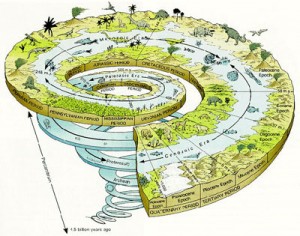One of the hardest concepts to get across to people is the immensity of geologic time. Geologists casually toss around numbers in the millions of years, even billions of years, but how do you really get your mind around such huge periods of time?
For most people the idea of 100 years is a long time back. For example, World War I was fought almost 100 years ago. The Civil War ended almost 150 years ago. The Great Pyramid of Giza was constructed about 4,600 years ago, and that is ancient history. But to even get to the first 1 million years, you have to go back 217 times further.
One scheme for putting this into perspective is the use of the “geologic year.” If we compress all of geologic time into a single year, beginning on January 1, and the present day is midnight on New Year’s Eve, we can place geologic events on the calendar.
The first live appears on the Earth about Feb 25th, and for most of the year single-celled life dominates. The Cambrian Period, when hard-shelled life and most of the modern invertebrate marine groups appear, happens in the crisp fall of Nov 15th. The year is almost over, and we have not seen a single vertebrate.
The famed dinosaurs first arrive on the scene about Dec 9th, and hang around for an incredible long time, until Christmas on Dec 25th when they go extinct. The dinosaurs and the other reptiles that lived alongside them dominated the large vertebrates for over two weeks, and the next period, the Age of Mammals has lasted less than the last week of the year.
On this scale it takes 2 hours to tick away a million years. Modern humans (Homo sapiens) arrive at 11:37 pm on New Year’s Eve and all of recorded human history (last 5,000 years) takes place in the last 35 seconds before the ball drops.
So, next time you gaze at an outcrop or play with your kid’s dinosaur toys (it’s OK, we all do it), really try to imagine how far back in time you are peering. It is mind-boggling.
Note: To calculate your own dates for the geologic calendar, here are some numbers for you. One day = 12,328,767 years; one hour = 513,699 years; one minute = 8,561.6 years; one second = 142.69 years. Have fun.
